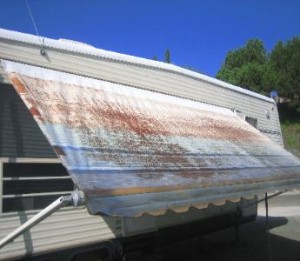Your RV awning fabric provides shade during hot summer days, a place to park your bikes, or a great spot to put a table for eating your meals.

Wear and tear happens with age, and eventually you will need to replace an RV awning. While this should be easy enough, with a few helping hands, if you or the others helping, have no knowledge of tension-loaded springs, let a professional replace your RV awning for you. Otherwise, here are the steps you should take:

Replacing your RV awning can be a simple process, if you know your way around tension-loaded springs, but when in doubt, always consult a professional.
Follow your owner’s manual for tips on how to extend the life of your awning. Awnings can shield you from the sun, but when the wind pick ups up can act as a “sail,” and if it rains, can “pool” water. Make sure to secure it properly, if it is windy, and retract it during bad storms so that strong wind does not damage it, and rain does not collect in it. If it is raining, but the weather is not too severe, you can also set it up so that one end is lower than the other, so the rainwater can escape down one side. In this way, you can still have the protection of the awning without compromising it.